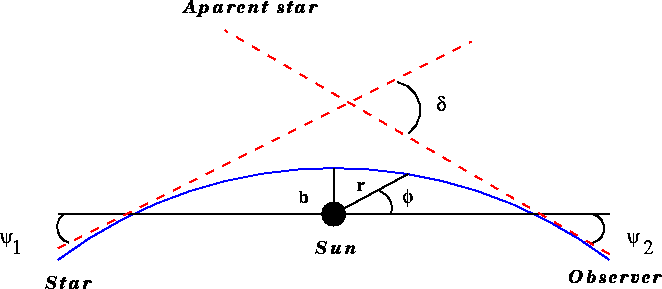We next consider the case of the trajectory of a light ray in
a spherically symmetric static gravitational field.
The calculation is essentially the same as that given in
the last section, except that light rays travel on null
geodesics, so that ![]() . The differential equation we need
to solve is therefore
. The differential equation we need
to solve is therefore
![]()
In the limit of Special Relativity, the last term vanishes and the equation becomes
![]()
The general solution can be written in the form
![]()
where b is the closest approach to the origin [ or impact parameter, see Figure 8.2 ].

Figure 8.2: Deflection of light ray
This is the equation of a straight line as ![]() goes
from
goes
from ![]() to
to ![]() . The straight line motion is
the same as predicted by Newtonian theory.
. The straight line motion is
the same as predicted by Newtonian theory.
We again solve the General Relativity problem by taking the general solution to be a perturbation of the Newtonian solution:
![]()
where we have taken ![]() for convenience. It follows
that the equation for
for convenience. It follows
that the equation for ![]() is:
is:
![]()
This equation can be solved by trying a particular integral of the form
![]()
This gives [ Assignment 7 ]
![]()
so the full solution is
![]()
Let us now calculate the deflection of a light ray from a star which just grazes the sun [ see Figure 8.3 ].

Figure 8.3: Diagram showing the total deflection
When ![]() ,
, ![]() , so
, so
![]()
at the asymptotes ![]() and
and ![]() , and
taking
, and
taking ![]() we get:
we get:

The total deflection is ![]() :
:
![]()
This works out to be about 1.75'' and was confirmed by Eddington in 1919 during a solar eclipse.
Another beautiful example of the bending of light is the gravitational lens. Take the example of a Quasar directly behind a galaxy in our line of sight.
The distance of closest approach corresponds to an angle
![]()
Now from the diagram [ see Figure 8.4 ] above we have
![]()
since both ![]() and
and ![]() are small. It follows that
the impact parameter can be written as
are small. It follows that
the impact parameter can be written as


Figure 8.5: Einstein ring lensing event
So the image of the quasar appears as a ring which subtends an angle
